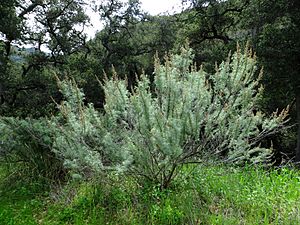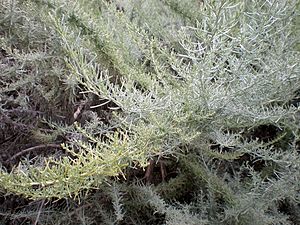California sagebrush facts for kids
California sagebrush (scientific name: Artemisia californica) is a type of shrub found in western North America. It belongs to the sunflower family, also known as Asteraceae.
Quick facts for kids California sagebrush |
|
|---|---|
 |
|
| Scientific classification | |
| Genus: |
Artemisia
|
| Species: |
californica
|
| Synonyms | |
|
|
Contents
Where California Sagebrush Grows
This shrub naturally grows in western California and northwestern Baja California. It is special because it only grows in the California chaparral and woodlands area. You can find it in places like coastal sage scrub, coastal strand, chaparral, and dry hills. It grows from sea level up to about 800 meters (2,600 feet) high.

California sagebrush is a key plant in chaparral areas, especially in the California Coast Ranges. Other plants like toyon and different types of sage also grow with it. These areas are a mix between chaparral and coastal sage scrub.
Some people think this plant releases chemicals into the soil. These chemicals might stop other plants from growing too close to it. This is called allelopathy.
What California Sagebrush Looks Like
California sagebrush grows from its base and spreads out, forming a rounded shape. It can reach a height of 1.5 to 2.5 meters (5 to 8 feet). Its stems are thin and bendy. They can be smooth or a little fuzzy.
The leaves are usually between one and 10 centimeters long. They are divided into 2 to 4 thin, thread-like parts. The leaves are hairy and can be light green or gray. Their edges often curl under.
The plant's flowers grow in groups called inflorescences. These groups are narrow and have leaves. The small flower heads are less than 5 millimeters across. Each head has 6 to 10 female flowers and 15 to 30 disk flowers. These flowers are usually yellowish, but sometimes they can be red.
After flowering, the plant produces small fruits called achenes. These fruits are sticky and about 1.5 millimeters long. They have a tiny crown-like structure on top.
California sagebrush contains special chemicals called terpenes. These chemicals give the plant a very strong and pleasant smell.
How People Use California Sagebrush
Cooking and Tea
Even though it's called sagebrush, Artemisia californica is not a true sage like the one you might use in cooking. However, it can still be used as a spice in food. You can also make a tea from its leaves.
Growing and Caring for the Plant
This shrub is often grown in gardens as an ornamental plant. It's popular in native plant gardens and wildlife gardens. People also use it to help restore natural areas that have been damaged. There are some types of California sagebrush that grow shorter. These are good for groundcover in gardens that don't need much water (this is called drought tolerant gardening).
California sagebrush loves full sun. It grows best on slopes that face west or north. It doesn't need much water, especially in the summer. The type of soil doesn't seem to affect how well it grows. This plant needs wildfire to help its seeds sprout. After a fire, burned plants can also grow back from their roots.
Animals usually don't eat California sagebrush. This is probably because of the bitter chemicals (terpenes) it contains. However, the plant provides good shelter for small birds and other animals. It's an important home for the endangered California gnatcatcher, a small bird.
See also
 In Spanish: Artemisia californica para niños
In Spanish: Artemisia californica para niños


